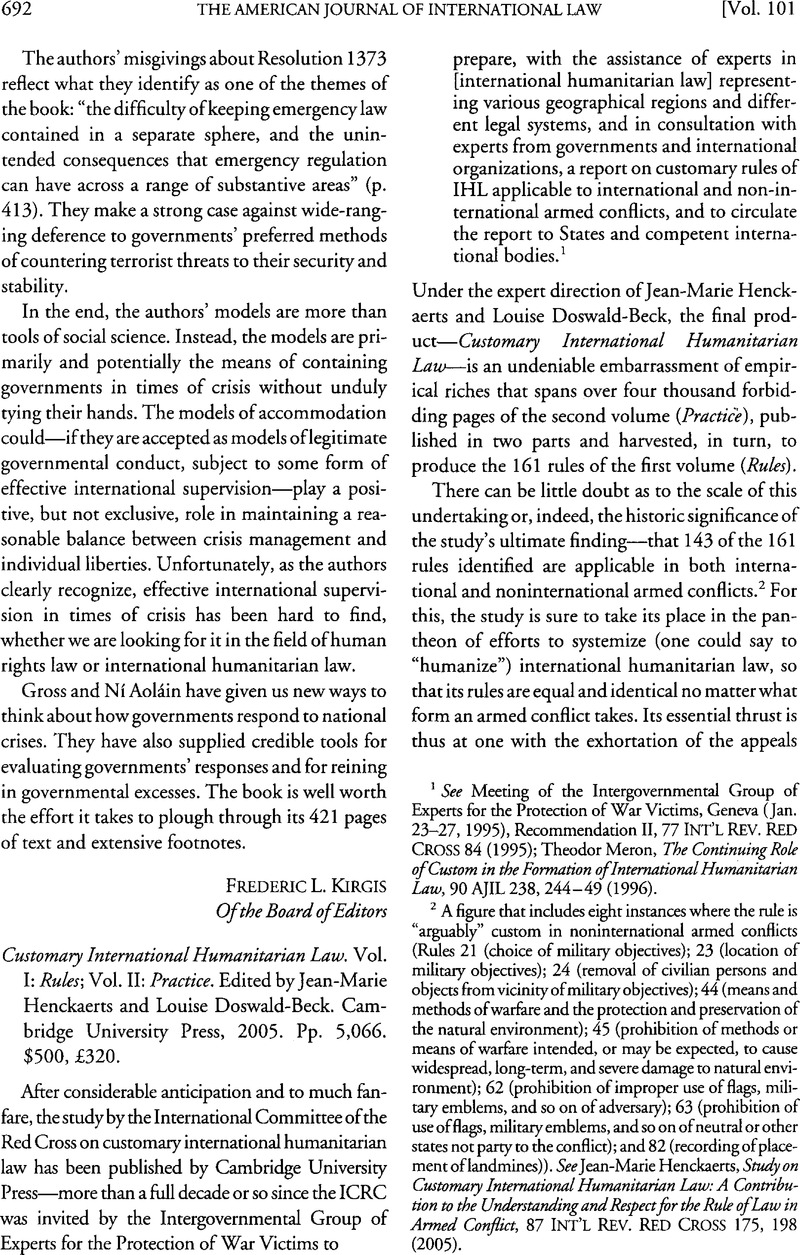Published online by Cambridge University Press: 27 February 2017

1 See Meeting of the Intergovernmental Group of Experts for the Protection of War Victims, Geneva (Jan. 23–27, 1995), Recommendation II, 77 Int’l Rev. Red Cross 84 (1995); Theodor, Meron, The Continuing Role of Custom in the Formation of International Humanitarian Law, 90 AJIL 238, 244–49 (1996).Google Scholar
2 A figure that includes eight instances where the rule is “arguably” custom in noninternational armed conflicts (Rules 21 (choice of military objectives); 23 (location of military objectives); 24 (removal of civilian persons and objects from vicinity of military objectives); 44 (means and methods of warfare and the protection and preservation of the natural environment); 45 (prohibition of methods or means of warfare intended, or may be expected, to cause widespread, long–term, and severe damage to natural environment); 62 (prohibition of improper use of flags, military emblems, and so on of adversary); 63 (prohibition of use of flags, military emblems, and so on of neutral or other states not party to die conflict); and 82 (recording of placement of landmines)). See Jean–Marie, Henckaerts, Study on Customary International Humanitarian Law: A Contribution to the Understanding and Respect for the Rule of Law in Armed Conflict, 87 Int’l Rev. Red Cross 175, 198 (2005).Google Scholar
3 Prosecutor v. Tadić, Case No. IT-94-1-AR72, Decision on the Defense Motion for Interlocutory Appeal on Jurisdiction, para. 119 (Oct. 2, 1995).
4 Consider, however, Adam, Roberts, What Is Military Occupation? 1984 Brit. Y.B. Int’l L. 249, 255, 296–97.Google Scholar
5 The photograph is the metaphor of the moment: in his foreword to the study, ICRC President Jakob Kellenberger regards the “idea” of the project as “to capture the clearest possible ‘photograph’ of customary international humanitarian law as it stands today” (p. I–xi).
6 Office of the Press Secretary of the White House: Fact Sheet Status of Detainees at Guantanamo (Feb. 7, 2002), at <http://www.whitehouse.gov/news/releases/2002/02/print/20020207–13.html=.
7 See William, H. Taft IV, The Law of Armed Conflict After 9/11: Some Salient Features, 28 Yale J. Int’l L. 319, 321–22 (2003)Google Scholar (“While the United States has major objections to parts of Additional Protocol I, it does regard the provisions of Art. 75 as an articulation of safeguards to which all persons in the hands of the enemy are entitled.”).
8 See Baxter, R. R. & Thomas, Buergenthal, Legal Aspects of the Geneva Protocol of 1925, 64 AJIL 853, 855–56 (1970).Google Scholar
9 At <http://www.defenselink.mil/home/pdf/Customary_International_Humanitiarian_Law.pdf=, reprinted in 46ILM 511 (2007).
10 As will be done in Perspectives on the Icrc Study on Customary International Humanitarian Law (Elizabeth, Wilmshurst & Susan, Breau eds.) (forthcoming 2007).Google Scholar
11 126 S. Ct. 2749 (2006).
12 HCJ 769/02, at <http://elyonl.court.gov.il/Files_ENG/02/690/007/a34/02007690.a34.pdf>.